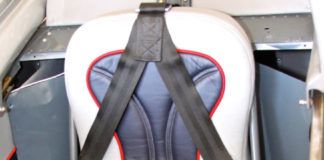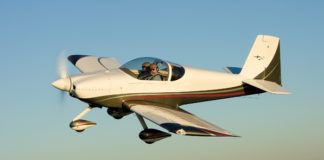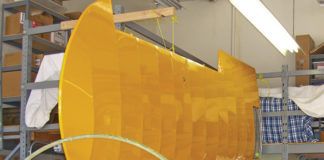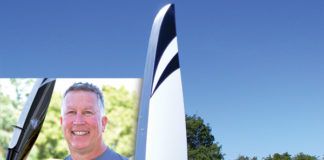Those of you who attended that big airshow in the state of Wisconsin last summer might have noticed a curious juxtaposition. If you had started a soft-serve ice cream before dropping by the Vans Aircraft booth to see the RV-12 prototype, you probably would not be licking the cone by the time you arrived in Camp Schlitter, where the RANS S-19-painted, primped and well along in flight test-rested outside the tent. Unless you were utterly absorbed in satisfying your sweet tooth, the similarities between the RV-12 and the S-19 would be striking.
Welcome to modern set-point design, where key parameters of Light Sport Aircraft are tightly grouped and the result is, for now, many similar looking aircraft crowding the fence line. When two intelligent and prolific designers
like Randy Schlitter and Richard VanGrunsven arrive at more or less the same place, you know orthodoxy is just around the corner.
Actually, its not that simple. First glances have the RV-12 and the S-19 as adjoining peas, but they issue from dissimilar legumes. The general proportions are similar, plus they are all-metal, low-wing, engine-in-front, bubble-canopy designs using a 100-horsepower Rotax 912S, which seems to be the configuration of choice among new LSA-intended designs. One of the liberating qualities of the current Light Sport regulations is that human factors can be brought forward, while pure performance tends to take a step rearward. After all, the top speed is set at 120 knots (138 mph) at maximum continuous power at sea level. By the time you have enough wing to meet the 45-knot clean stall-speed requirement of the rule, plus sufficient tail volume to meet stability requirements (as in the ASTM specs), its unlikely that any design is in danger of whipping past the speed limits, though some designs are definitely walking right along that line. So without having to seek maximum cruise speeds, designers can opt for a wider cabin, taller canopy and other compromises that might add a bit of drag, but all benefit the pilot and passenger rather than buff up the specifications sheet.
Some Examples, Then
On the S-19, that huge sliding canopy, under which most average-size pilots look like shrimp in a hotel salad, provides superb visibility and headroom for Herman Munster. The cabin is beamy, with 43.5 inches between the sidewalls, enough to allow for a fist-width space between the seats for the manual flap handle. To preserve visibility over the nose, the top of the instrument panel is low. This tactic somewhat limits how much the panel can carry, but with todays electronic instruments thats a more-than-fair compromise. (The factory prototype carries a Dynon EFIS-D100 on the left and an EMS-D120 on the right, sharing flight and engine data between them. There are no analog gauges besides a slip/skid ball. Early on, the prototype had an analog airspeed indicator, but thats been replaced by an air vent.) The first impressions after stepping up on the wing and sliding down over the cabin sidewalls into the firmly padded seats are overwhelmingly positive. For the pilot, the S-19 is airy, comfortable and, thank you very much, ergonomically conventional.
Twin sticks emanate from the floor, and the single throttle is in the middle, just below the Z-shaped kick-forward in the panel, with choke, carburetor heat and cabin heat knobs arrayed vertically beneath it. Of course, because this airplane is primarily an Experimental/Amateur-Built that meets the performance requirements of LSA, builders can put these (and any other minor controls) wherever they want.
Under the Skin
Given Schlitters proven ability to work with many kinds of materials, why plain riveted aluminum? He puts it simply:
These were the best materials for the job, the most familiar for builders and easy to translate into series production. Early this year, RANS received its SLSA approval and announced plans to build the S-19 as a ready-to-fly model by the third quarter of 2008; introductory price is $110,000.
For the homebuilder, thats a hefty sum against the basic kit costs (adjusted for the company’s first-of-the-year 5% bump) of around $28,000. That price includes the basic airframe and a firewall-forward kit for the 912S, but no paint, avionics or interior. And no engine, which in the case of the 912S is a moving target. It was $17,325 at press time. Plug in $1600 for the Sensenich fixed-pitch, ground-adjustable prop while you’re at it.
Could you build an S-19 for $50,000? If you were prudent with avionics and can wield a paint gun without hurting yourself, sure. Improve your odds by finding a used 912S (not all that likely) or an 80-hp 912 (better chances here) to install instead of a new powerplant.
Built for the Builders
Schlitter is justifiably proud of the design because it is aimed at making life easier for the amateur builder, not just his own crew. For example, the entire airplane uses blind pulled rivets-please don’t call them “pop” rivets-serious (and expensive) structural-grade items, not something from Ace Hardware. Virtually every hole those rivets will occupy has been pre-punched at the factory, so few jigs and fixtures are necessary.
Builders are advised to construct one large, flat table as the extent of the fixtures. For the tail group, small wood jigs are needed, but they are provided with the kit. The remaining parts are typically match-hole-assembled with conventional Clecoes then pull-riveted. Go to the company’s web site and see the construction photos of the S-19. There are at least a couple thousand words on the simplicity of the airplanes structure.
Two notable items in terms of the S-19s makeup. First, the main wingspar is primarily a CNC-machined piece with just a few tabs and doublers secured with solid rivets. None of those rivets has to be set by the builder; in fact, there’s no quickbuild option per se. While the wing and fuselage are not as far completed as in, say, a modern Vans quickbuild kit, the simplicity of the design is expected to take up the slack.
Second is that Schlitters emphasis has been toward safety, which is often not high on the list of bullet points for Experimentals. He cites energy-absorbing seats, good visibility, a strong rollover structure and other design elements, including plastic fuel tanks located behind the mainspar. Schlitter says these tanks are by nature rupture resistant, and are protected from frontal impact by the spar. Moreover, they are easy to install and can be removed from the lower wing panel if they should ever need maintenance. Anyone who has fought with Pro-Seal and wet tanks will appreciate this feature.
Hey, Whats That?
Schlitter followed a few other unfamiliar avenues, at least to him. At the back of the S-19 is an all-flying stabilator, as youd find on a Piper Cherokee. “The idea is simple, to have a smaller, lighter, more highly loaded airfoil doing more work,” says Schlitter. So to help reduce parts count and weight, this seemed a good alternative. In Cherokee fashion, the stabilator is fitted with a substantial counterbalance out ahead of the leading edge, tucked into the tailcone; the anti-servo tab is adjusted to set pitch trim, and a light “downspring” bungee was added to help reduce surface float.
Other construction methods are more familiar. Where the RV-12 places the main wingspar behind the pilot and passenger, the S-19 is more conventional. A traditional two-spar wing allows the primary structure to enter the cabin just below the humans knees, directly below the thick, tubular-steel rollover hoop/windshield bow. Flat aluminum maingear legs are bolted to the outside of the belly and are separate pieces, rather than a single U-shaped piece as many other designs use, again to help reduce empty weight.
Speaking of which, weight is the one area that Schlitter would like to improve on the S-19. Originally intended to come in at around 750 pounds empty, the real number is 820. With 24 gallons of fuel and using the LSA weight limit of 1320, cabin load is limited to 360 pounds. Thats probably fine for many pilots and their passengers, but not generous, particularly in light of the S-19s large baggage bay rated for 70 pounds max. “We worked hard to get weight out of the airplane,” Schlitter says, “but you reach a point of diminishing returns. It gets harder and much more expensive to remove weight. We have kept developing [the S-19], and have removed 100 parts.” This is to be expected in an airplane that had no true conventional first prototype; this factorys airplane was built directly from production tooling thanks to the magic of CAD/CAM (computer aided design/manufacturing). In fact, a bigger challenge on may levels will be creating good manuals to go with the kit. Thats why RANS has had two different teams build the #1 and #2 airplanes and provide their feedback on the documentation and processes.
Lets See If Its Any Good
The day I flew the S-19 at the company’s Hays Airport facility was nearly perfect. Cold and windy in the morning, it warmed up and calmed down by late afternoon. Start-up and taxi are conventional. The free-swiveling nosewheel works fine, bolstered by a lot of rudder. With light winds, its possible to steer with just the rudder, using the powerful brakes only occasionally.
With two of us and 20 gallons of fuel on board, we were within 43 pounds of maximum gross weight, a good way to test performance. Initial acceleration from the Hays Airport (elevation 1998 feet, outside air temp 55 F) was very good. RANS says the S-19 will use 325 feet of asphalt to get airborne; not needing to get off that quickly, we allowed the airplane to accelerate to a comfortable rotation speed, which consumed closer to 600 feet of runway. Initial climb at 75 mph IAS provided 750 fpm at about 5200 engine rpm. At that speed, the nose is just above the horizon, but lower it slightly, accepting 82 mph in the climb, and cut the rate to a still respectable 500 fpm. RANS claims 900 fpm, which is probably achievable, but only with a high deck angle (as youd expect) and possibly a slight change to the adjustable prop for a bit less pitch.
Checking on performance, we leveled off at 6000 feet density altitude. (Have to love those auto-updating density altitude/TAS displays!) A two-way run at 70% power showed an average of 109 knots on the Garmin GPSMAP 396, which agrees fairly closely with the calculated TAS on the Dynons, 125 mph (108 knots). Optimum cruise is listed as 128 mph at 75% power on 5 gph. Bottom line: The S-19 prototype is right in line with book figures even without wheelpants. In fact, Schlitter says the SLSA version will not be sold with those fairings because its top speed would be very close to the legal limit.
We worked through a series of stability maneuvers and found the S-19 to have excellent manners. The airplanes tendency to return to trimmed airspeed after an upset is very good, with an immediate move away from the disturbance and positive damping in fewer than two cycles. Force feedback is good, aided by a reasonable amount of stick displacement, with the stick force per G of around 4 pounds/G. The only oddity I found was the airplanes tendency to “hang” slightly on small upsets caused by turbulence. When the S-19 is more positively displaced it responds immediately, but it is slightly more hesitant to get back on track when the disturbance is small. To be fair, this is a common characteristic of the stabilator-equipped Cherokee.
See If You Can Land This Thing
Stalls are actually fun in this airplane. Clean, it simply mushes along, refusing to break unless provoked. Dirty, the S-19 sits there shuddering and hammering and telling you seven ways to Sunday that the real stall is near. If you miss a full-flaps stall in this airplane, you’re just not paying attention. Or maybe not awake at all.
Landings are so much fun they ought to be illegal or at least heavily taxed. An approach speed of 70 mph IAS, slowing to 60 on short final, works well. All that over-the-nose visibility helps keep the runway in sight. The flight controls have a lot of authority-in fact, you may want to turn down your own rudder gain a bit-so that hitting your touchdown point is easy.
Schlitter says he designed the S-19 to be a docile trainer and a pleasant, undemanding airplane to own. (He talks at length about maintenance access and systems simplicity.) It is all that, but Schlitter and his crew worked the compromises masterfully. The S-19 is where it really should be in terms of handling and performance for the LSA market. Fine, good deal. But the bulk of the market will be among amateur builders who should look forward to the airplanes well-considered design points on the way to completing an airplane theyll ultimately love to fly. If this is design orthodoxy, well take it.
For more information, call RANS at 785/625-6346, or visit www.rans.com. A direct link can be found at www.kitplanes.com.




